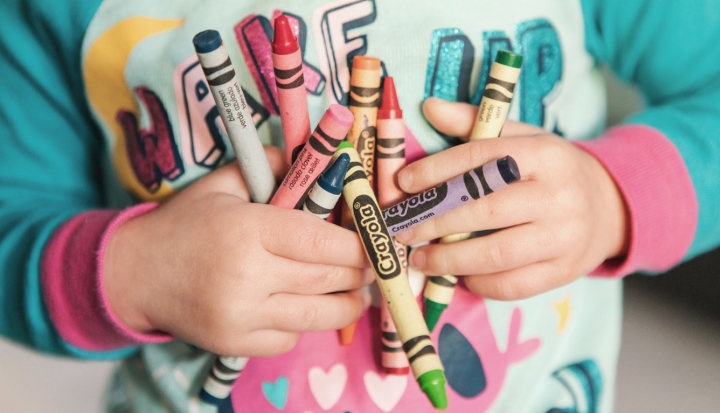When our oldest daughter started kindergarten, we replaced previously lazy mornings with a chaotic new routine of rigid uniforms, rushed breakfast, and wrestling kids into the car. Once we got the hang of it, I began to appreciate starting the day with a quiet drive—everyone together and safely contained in car seats. One day, halfway to school, I eagerly announced, “Let’s say a Hail Mary.”
My daughter met my eyes in the rearview mirror with a glare perfected at an early age—a learned behavior modeled by me, unfortunately. “We pray all day at school, Mommy,” she whined.
I knew I had to get creative.
Structure was not the norm in our disordered household, where moments were fast and scattered like toys across the floor. Teaching prayer was difficult to prioritize. We were happy our daughter could attend Catholic school but needed to find ways to encourage spirituality at home.
In Apostle Paul’s first letter to Thessalonica he instructs his audience to “Rejoice always, pray without ceasing, give thanks in all circumstances” (5:16–18). This sounds like a lot to ask, especially in a modern world that is already multitasking too much. But this verse is a gift.
Paul makes us privy to the idea that a joyful attitude can make everyday tasks prayerful. My kids have plenty of time to learn structured prayer but for now, while they are small, this is the kind of prayer I want them to know.
Children are naturally joyful creatures. The challenge lies in making prayer, even if unstructured, intentional. I spoke with a kindergarten teacher who has been in a Catholic school classroom for 22 years. She says:
“The beauty of prayer in a young child [is that] they pray with so much faith because they have not been exposed to a world that has told them otherwise yet. . . . I think the best way to help our children become natural prayers, is to make it intentional when [they] are small. It truly is important to make prayer a daily habit—one that comes as naturally as breathing. These positive habits are best learned by example. . . . Prayer isn’t accidental. It needs to be modeled and it needs to be fun and engaging for a child.”
In other words, just like that glare, prayer could be modeled too.
With that advice I began trying to set a better example, to weave prayer into our busy household in a more intentional way.
I have learned valuable lessons on what works for each individual child and what works for our family unit. Every day is different in our home, and so are the prayers. With four kids ranging from age 1 to 7, our goal has not been to keep a rigorous prayer routine, but rather to keep prayer in the routine.
Here are some prayer ideas that we have tried to incorporate into our lifestyle.
Breath prayers
They are easy, effective, and can be done anywhere. Our family’s dinner prayer can be labeled as a type of breath prayer—a loud and boisterous “thank you!” shouted to the heavens and any neighbors within earshot. It is irreverent, but our kids expect it and it has become a fun way for them to thank God for their family, their day, and their meal.
The breath prayer is an ancient Christian prayer form also known as the Jesus Prayer. Practitioners repeat a single word or phrase to the rhythm of their breath. The original prayer includes saying “Lord Jesus Christ” on an inhale then “have mercy on my soul” on the exhale.
These prayers can be individualized, are repetitive and easy to remember, and the centered breathing has a calming effect. One of my favorite breath prayers is to inhale “Lord” and exhale on “be my help.”
Movement prayers
Movement prayers encourage children to pray with mind, body, and soul and are effective with kinesthetic learners. They can involve any physical activity.
Our 3-year-old son is obsessed with basketball. So we shout out something or someone we are thankful for with each shot of the ball. Some days we begin with a stretching session, reaching up to God in praise, and then reaching down to thank God for what we have on earth. We sometimes end our session with a prayer for our health and talent. I am hopeful this will evolve and prayer will eventually be a natural part of my son’s basketball routine.
Visual prayer reminders
The kindergarten teacher I spoke with had some other ideas regarding sports. She referenced the Notre Dame football team tapping the “Play Like a Champion Today” sign before each game, adding that physical and visual reminders are extremely useful with children.
This can be a symbol they have chosen, something they can hold and see, that helps them grasp their connection to God. They can keep this symbol on their sports bag, serving as a reminder to stay connected with God throughout the activity.
Intention is important here. If we can intentionally meld prayer into our routines it will become familiar and tangible for our children.
Playful prayers
Amidst the hurdles of sports and extracurricular activities that are thrown into family life, it is also important to relax. In 2015 Pope Francis tweeted, “Parents, can you ‘waste time’ with your children? It is one of the most important things that you can do each day.”
He specified this idea again in a 2017 homily in Milan, reminding parents “playing with your children, ‘wasting time’ with your children, is also a way to transmit the faith. It is graciousness, the graciousness of God.”
As a mother I often find it difficult to play with my children, not because I don’t want to but because I feel pulled in so many directions, overwhelmed and hindered by basic household chores. When this inner struggle arises, I try to remember these words from our pope and take a few minutes to play with my kids.
Play can be powerful, and I am often surprised at how prayerful children’s’ pretend play can be as they offer kindness and solve struggles between their toys.
Colorful prayers
One playful activity in which our kids love to include us is coloring. Our best evenings can be spent heads down around the table, focused on coloring pages.
Coloring can be meditative, providing time and space to focus mentally while your hands are busy. A fun prayer game is to choose colors that correspond with prayer intentions. Each color serves as a prayer for that intention when used.
Another way is to apply a prayer device for each color. Children can remember this like a traffic light. Go and give thanks when using green. Slow down and ask for God’s help when using yellow. Stop and listen to God when using red.
Meditative prayers
Coloring and crafting are great ways to get in touch with kids and help them get in touch with God. Our second daughter, now 6, has been a meticulous crafter since a very young age. Her hands wielded scissors before age 3, cutting out precise shapes and characters unimaginable for such a small child.
Today, crafting has become her meditation. It is cathartic, and we now realize it is an important part of her daily routine. She seems to use this time listening to her heart while working through troubles and delights. I hope that she continues to share this beautiful, quiet time with God.
Prayerful listening can be arduous, especially when our lives are rarely quiet. We are bombarded with media consumption and its influences, and communication in all its forms can be deafening. Prayer is a form of communication. Prayer is not a way to talk at God, but rather a way to talk with God.
Christian prayer is especially exciting because it can be a conversation with the Father, the Son, and the Holy Spirit. God wants to be a part of our lives, even the youngest of those lives, and part of our conversation.
Prayer songs
Conversations come in many forms. “Singing is a great way to make connections to God at this age,” notes the teacher I spoke with. Prayers and rituals become entertainment when turned into songs—repetition and melody make them fun and memorable.
Recently at Mass our parish has been holding hands across the aisles and singing the Lord’s Prayer. This added musicality has changed a rote prayer into a more meaningful experience for the congregation.
Music is powerful and mentioned many times in the Bible. Encouraging children to use the gifts God entrusted them, like that of singing, is especially important.
Our family never got into saying structured prayers on the way to school, but now we belt out songs from Vacation Bible School—complete with hand motions that even the youngest knows. Starting our day in song and dance sets a positive tone and reminds us where to turn when we are in need.
Teaching children to pray is a challenge. Family routines vary and are vastly different from those of previous generations. As children grow their needs will change, but their emotional need for you as parents to provide foundation as they navigate their own spirituality will remain.
Spirituality lies in the individual heart, however, and how one glorifies God is a personal choice. Be grateful you can be there for your children and be confident that God will be listening whenever and however they choose to seek prayer.
I am certain we do not have the most prayerful household. We have a cross and a Bible and occasionally make it to Mass on Sunday. Some nights we say a structured bedtime prayer and others we whisper a quick breath prayer into the pillow.
Parenting is a puzzle, and we will never have it solved. But I can rest assured that in this ever-changing world we are taking small, deliberate steps to help our children know how to seek an authentic relationship with God and to experience God’s love and guidance.
Image: Kristin Brown on Unsplash
















Add comment